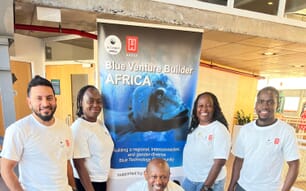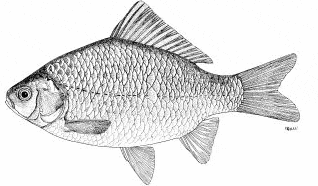
Biological features
Body laterally compressed and thick, round abdomen; standard length 2.1-2.8 times body height and 3.1-4.1 times head length; length of head larger than body height; small and short head; short snout; terminal mouth and arch shaped; lower jaw slanting upwards slightly; thick lip; no palpus; 37-54 gill rakes on the first outer gill arch, gill rake long; one row of pharyngeal teeth on each side, laterally compressed, formula 4--4; 27-30 scales in lateral line. Tip of pectoral fin can reach the base of ventral fin; dorsal fin ray: 3, 15-19; pectoral fin ray: 1, 16-17; ventral fin ray: 1, 8; anal fin ray: 3, 5; body colour: silvery grey, deeper colour in dorsal portion, lighter colour in abdomen; colour of fins: greyish.
Profile
Historical background
The culture of crucian carp was initiated in China. The earliest activity can be traced back to the East Han Dynasty (25-189 A.D.), according to archaeological studies, to the Song Dynasty (960-1279 A.D.) and according to written records. However, production was limited to a rather small scale. Aquaculture of this species was limited to China and Japan until the mid-1960s. Since then it has gradually expanded to many other countries and regions, including Taiwan Province of China, Belarus, Republic of Korea, and Uzbekistan. The major producer has always been China, whose production has expanded from less than 2000 tonnes in 1950 to nearly 1.7 million tonnes in 2002 (99.6 per cent of the global total).
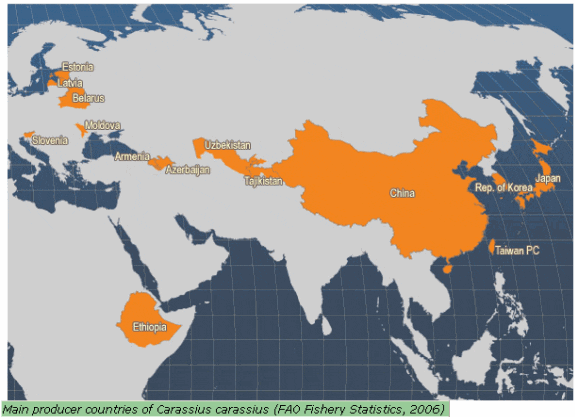
Habitat and biology
Crucian carp is a freshwater fish that inhabits lakes, rivers and reservoirs in various countries in Asia and Europe.
They normally dwell in the bottom layer of the water column. Comparatively, they can tolerate a wide range of environmental conditions. They are sedentary fish, which can propagate naturally in various types of water bodies, such as rivers and lakes. Crucian carp is basically an omnivore that naturally feeds on organic detritus, filamentous algae, small benthic animals, and pieces and seeds of aquatic weeds. However, the fry/larvae feed on zooplankton. In addition, in aquaculture, they well accept artificial feed, such as by-products from grain processing and oil extraction, and pelleted feed. Rainfall, water level and temperature changes are the stimuli for reproduction. The presence of aquatic weeds is also important for spawning; they serve as the substrata for the eggs, which are adhesive. Crucian carp is a medium-size fish with a moderate growth rate that can reach 1.25 kg.
Production
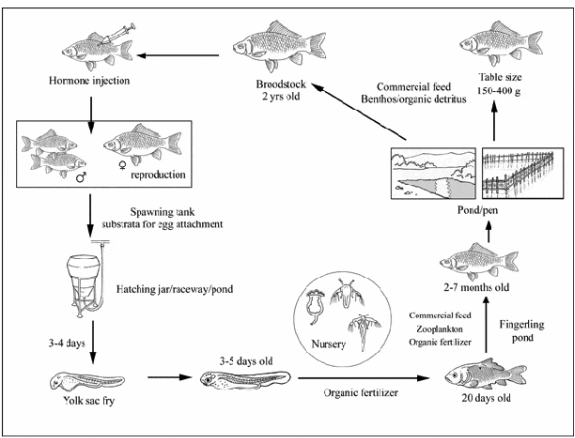
Production systems
The major system used for rearing crucian carp is earthen pond culture, but rice paddies are also used in some areas of China.
Pond preparation
Earthen ponds are used for both spawning and nursing of crucian carp. The pond size is usually 0.07-0.2 ha and 1.5-2.0 m deep. Ponds are chemically cleared to eliminate all harmful organisms after totally drying; quicklime is the most commonly used chemical for eradication, usually applied at 900-1125 kg/ha. Organic fertiliser (animal and green manure) is commonly applied 5-10 days before stocking, depending on the water temperature, to increase the biomass of natural food organisms (zooplankton). The quantity of organic fertiliser used is usually 3000 kg/ha for animal manure or 4500 kg/ha for green manure. Green manure and animal manure may be used simultaneously, but the quantity of each is reduced accordingly.
Seed supply
Artificial propagation forms the major supply of seed for the culture of crucian carp nowadays, although natural seed is available in various types of water bodies. At present, the most commonly cultured crucian carp is Carassius carassius gibelio, which is produced through gynogenesis with female Carassius carassius gibelio and male Xingguo red common carp. Such heterogenous gynogenesis provides all-female offspring, whose growth rate is 30-40 per cent higher than the original fish. Other species and strains of crucian carp are also cultured in various areas of China.
Hatchery production
Well-selected mature broodstock are released into spawning tanks/ponds/cages. Hormone injection is optional, since the fish can spawn well without it. However, hormone injection enables the fish to spawn more synchronously. The most important technique is to provide substrata of grass bundles, palm leaves, fine tree branches and plastic weeds in the water column of spawning facilities in which egg attachment can take place. Eggs can be hatched in earthen ponds where harmful organisms have been eliminated in advance. The eggs are simply moved into the spawning pond together with the substrata and fixed in the water column.
For better hatching, eggs can also be hatched in running water (raceway or jar). The substrata with eggs attached can simply be hung in the water column. The eggs can also be removed from the substrata for hatching in raceways or jars. Egg adhesivity is removed by mixing with clay solution prior to stocking. The hatchlings (fry) are transferred to nursery ponds when they are able to swim well and feed actively.
Nursery
Monoculture is the normal method for the nursery stage. The stocking density is usually 1.5-2.25 million/ha; the exact level depends on the length of the rearing period (2-3 weeks, which in turn mainly depends on water temperature) and the size required. Organic fertilisation is carried out, ranging from 1 500-3 000 kg/ha every 4-5 days for animal manure or green manure, depending on water fertility. Soybean milk may also be used as both direct feed and fertiliser, to replace organic fertilisers in the nursery operation; the usual application level is 3-5 kg (dry soybean)/100 000 fish daily. The use of soybean normally increases production costs, but it is an easy method to handle. The application of a paste-form of soybean cake or other by-products from grain processing is required from the 5th day after stocking, usually applied at 1.5-2.5 kg/100 000 fish daily. Normal survival rates in nursery ponds are 70-80 per cent, although they may reach over 90 per cent under good management.
The fish usually reach the size of about 30 mm after 2-3 weeks. These are called summer-fingerlings in China and are then ready for fingerling rearing. Conditioning through careful netting and holding the fish at high density for a while (several hours) is required before transferring the summer-fingerlings to fingerling ponds; this practice increases the tolerance of the fish to transport stress.
Rearing fingerlings
Summer-fingerlings are not suitable for direct stocking in grow-out ponds. They need to be reared to a larger size (6-7 cm or larger) first. Fingerling rearing can be carried out in two different ways:
- To produce fish that can reach marketable size within the first year, summer fingerlings are stocked in fingerling ponds at 90 000-120 000/ha. After one month, the fish will reach about 6 cm and can be transferred to grow-out ponds for marketing within one year (one-year cycle fish).
- It is also common practice to rear crucian carp in fingerling ponds until the end of the year, in which case they are stocked at 150 000-300 000/ha. The fish can reach 10 cm (25 g) or even more by the end of fingerling rearing. Survival rate is 80-90 per cent. At first, the fish mainly feed on natural foods enhanced by fertilisers or soybean milk. Later, additional commercial feeds (paste-form of soybean cake, rapeseed cake, wheat bran, etc.) are needed for optimal growth. These fingerlings are used to stock grow-out ponds in the following year, resulting in two-year cycle fish that achieve much larger market size and value than one-year cycle fish.
Ongrowing techniques
The most commonly adopted ongrowing techniques are polyculture in ponds/pens and rice paddies. Crucian carp is a bottom fish with relatively slow growth and production may often be relatively limited.
Polyculture in ponds/pens (semi-intensive to intensive)
In this system, crucian carp may be stocked either as the major species or as a secondary species, together with other carps. When crucian carp are the major species, the stocking rate is 22 500-30 000/ha of 25-50 g fish. Silver and bighead carp are also stocked as secondary species. After one year, the fish usually reach 150-400 g and production can reach 4000-6000 kg/ha. The production of secondary fish can also reach 3000-4500 kg/ha, giving a total productivity of 6000-10 000 kg/ha.
When crucian carp is the major species, the fish are mainly fed with commercial feeds. Crucian carp are omnivores that feed on both natural food and commercial feeds. Pelleted feed is becoming more popular when crucian carp is the major species in grow-out. Feed ingredients of pelleted feeds mainly consist of by-products from oil extraction (such as soybean cake) as the major protein source, and grain processing. The addition of animal protein (fish meal) is very limited (
Crucian carp can also be stocked as a secondary species; in this case the stocking density is normally 1500-1800 fish/ha of 7-10 cm fish. Finally, the fish can reach 300 g and crucian carp production can achieve 450-900 kg/ha, which usually accounts for 5-10 per cent of total production. When cultured as a secondary species, no special feeding is required for the fish. Crucian carp can also be cultured as secondary species in pens in shallow lakes; stocking and production levels are similar to pond culture.
Extensive culture in rice paddies
Crucian carp is also suitable for culture in rice paddies; stocking rates are 750-1500/ha. The fish mainly feed on natural food. Production can reach 300-450 kg/ha. This form of culture is also beneficial to rice, as a means of pest control and tilling the soil.
Harvesting techniques
Crucian carp, being a bottom-dwelling fish, are difficult to harvest effectively without draining the pond. Harvesting takes place at the end of the culture period firstly by netting at a reduced water depth, followed by total harvesting after drainage. Selective harvesting is also practiced by some farmers for balanced marketing; in this case the normal method is to use a casting net.
Handling and processing
Farmed crucian carp is entirely sold live or fresh. Drying and salting is only used for crucian carp caught from natural water bodies (rivers and lakes) by some traditional inland fishers.
Production costs
This varies according to the culture practice used but is normally below USD 0.70/kg.
Diseases and control measures
The major disease problems affecting crucian carp are included in the table below.
| DISEASE | AGENT | TYPE | SYNDROME | MEASURES |
|---|---|---|---|---|
| Bacterial Septicemia | Aeromonas sobria; Aeromonas hydrophila; Yersinia ruckerri; Vibrio sp. | Bacteria | Hyperaemia at different positions of body; protruded eyeball; swollen anus; expanded belly; erected scales; gill rotten and reduced feeding | Disinfect fish and culture environment with quicklime and potassium permanganate; 'Yu Tai III' (commercial drug of multi herb ingredients) through medicated feed |
| Scale erecting disease | Pseudomonas punctuta f. ascitae | Bacteria | Rough body surface; erected scale and scale sac filled with bloody liquid; difficulty in breathing and keeping balance; swollen belly and slow movement; high mortality | Careful handling of fish in transportation and stocking; disinfection of pond with quicklime or bleaching powder; dipping fish in solution of potassium chloride and sodium bicarbonate or liquid of garlic |
| Stigmatosis | Aeromonas punctata sub. punctata | Bacteria | Red round spot on skin and muscle near the anus of fish; loses scales; rotten skin and muscle even reaching the bone; physically weak and slow in movement; much reduced feeding; finally dies of exhaustion | Spraying of solution of bleaching powder or furazolidone in pond; immersion of potassium permanganate or furazolidone solution; other antibiotics (but caution about food safety) |
| Saprolegniasis: Dermatomycosis | Saprolegnia spp.; Achlya spp. | Fungi | Whitish fungal mycelia visible on body; cotton-like; much weakened or even dies of exhaustion | Careful handling of fish and disinfection of pond with quicklime; immerse infected fish in potassium chloride solution or malachite green solution |
Suppliers of Pathology Expertise
Assistance can be obtained from the following sources:
- Research Institute of Hydrobiology, CAS, Wuhan City, Hubei Province, China.
- Shanghai Fisheries University, Shanghai, China.
- Pearl River Fisheries Research Institute, CAFS, Guangzhou City, China.
- Freshwater Fisheries Research Centre, CAFS, Wuxi, Jiangsu Province, China.
- Zhejiang Provincial Freshwater Fisheries Research Institute, Huzhou City, Zhejiang Province, China.
- National Research Institute of Aquaculture, Nansei, Watarai, Japan.
Statistics
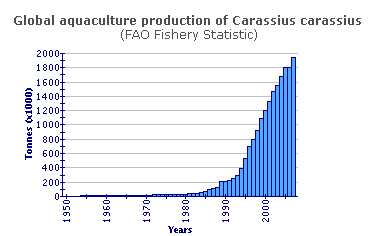
Global production of farmed crucian carp was only 2977 tonnes in 1950 but had reached 1 702 778 tonnes by 2002, an increase of more than 572 times in 52 years. Crucian carp ranks 6th among all cultured freshwater fish globally and contributed 7.4 per cent of the world freshwater aquaculture production in 2002. Most of the expansion was in China where the average annual growth rate between 1993 and 2002 was 21.6 per cent/yr. Expansion in other countries has been much slower, due to the relatively small size and large number of fine inter-muscular bones, which make the fish less acceptable to consumers in many countries. Taiwan Province of China is another important producer; its annual production was maintained above 3 000 tonnes/yr in the early 1980s (with a peak of 3764 tonnes in 1981) but has fluctuated wildly; from 1997-2002 it was in the 2 000-2 500 tonnes/yr range. Production in Japan, which has a long history of cultivating this species, is much less now than it was in the late 1960s.
The total value of cultured crucian carp production globally was USD 1.20 billion in 2002, representing an APR of 15.4/yr. This apparently slower rate of expansion in value is mainly due to the devaluation of Chinese currency against the US dollar.
Market and trade
At present, crucian carp is basically a locally consumed product. Traditionally, crucian carp is consumed fresh. Almost all cultured production is marketed live or fresh; there is almost no processing, except a small quantity of dry/salted fish produced from wild-caught fish. Crucian carp has a moderate price that is affordable to middle- and low-income people. There has been a considerable decline in the global average unit value of crucian carp in the last 10 years according to FAO data; by 2002 it was only USD 0.704/kg. There is a big gap between this figure and the retail market price, which has ranged between USD 0.90-1.30/kg in recent years. There is no specific control over the marketing of crucian carp as it is basically for local consumption.
Status and trends
Crucian carp has been cultured for nearly 2000 years in China. However, it was not considered as an important species due to there being an abundant resource in natural water bodies and its relatively slow growth. Efforts to develop of culture techniques and other related studies were very limited before the mid-1980s; since then, more efforts have been made in research and development as it has taken a more important position in Chinese aquaculture. Improving growth performance has been a priority. Application of heterogenous gynogenesis in crucian carp achieved substantial progress in this respect. Many improved strains have been developed through this technique with various varieties of Carassius carassius gibelio (female) and common carp (male); these usually give 30-40 per cent higher growth rate than the parent fish and 2-3 times more than other crucian carp varieties. More recently, tetraploids of heterogenous gynogenesis crucian carp were successfully developed, which not only improves growth performance but also rules out the possibility of contaminating the natural population with genetically modified fish.
As noted above, output in Taiwan Province of China and Japan has declined in recent years. This may be because of changes in consumer demand. Despite its delicious taste and fine meat texture, crucian carp contain a large quantity of fine inter-muscular bones, which may limit acceptance by the modern consumer. Producing larger fish (about 500 g) could significantly alleviate this problem.
Other research work has been focused on the control of the significant diseases of crucian carp. The best-studied disease is bacterial septicemia. Preventative and curative methods have been thoroughly studied. Nutritional studies and the development of compound feeds for crucian carp are far behind but pelleted feeds are more and more commonly used in intensive culture.
Crucian carp is a preferred fish in most parts of China, due to its good meat quality and high nutritional value. Progress in genetic improvement has significantly improved growth rates, and enhanced the marketable size. This makes crucian carp more competitive and better accepted by consumers. Therefore, the prospect for further increases in production in China is quite positive; rapid expansion in production in recent years is good evidence of this. However, it may be a different picture in other countries. The most significant disadvantage of this species is the large number of fine inter-muscular bones, which makes it difficult to eat for people that are not accustomed to this. It is thus very unlikely that there will be a rapid increase in production outside China in the near future, or for crucian carp to become an important item in the international market.
Main issues
Crucian carp is an omnivore, and a very suitable secondary species in polyculture in ponds and pens. It is also a good for rice-paddy culture. In these cases it does not need special feeding and there is no negative impact on the environment or other fish. However, its intensive culture as a major species is more dependent on pelleted feed. Accumulation and discharge of various wastes to natural water bodies may cause adverse impacts. In addition, genetically improved strains may have an impact on the natural germplasm as the fish can breed naturally in various kinds of inland water bodies.
Responsible aquaculture practices
At least three issues need to be addressed in considering responsible aquaculture practices for crucian carp culture:
- Widespread introduction of genetically improved crucian carp may cause significant impacts on the biodiversity of this species in natural water bodies in China and elsewhere. This species can swim strongly against the water current and could easily escape from farms. It can spawn easily in all kinds of inland water bodies. The opportunity for genetically modified crucian carp to cross breed with the natural population is considerable. This may contaminate the germplasm and affect the biodiversity of the species. Controls on the proliferation of genetically modified crucian carp should be considered. Recent use of tetraploidy presents a chance to solve this problem.
- The use of antibiotics and other drugs in disease control is another issue. Crucian carp have strong disease resistance and tolerance to adverse environmental conditions compared with most cultured species. Disease is not a very significant problem when it is cultured as secondary species in semi-intensive polyculture systems. However, the intensive monoculture of crucian carp has become rather popular in some areas of China, characterised by high stocking densities and intensive feeding. This increases the chance of bacterial infections and parasitic diseases; as the result, the use of antibiotics and other chemicals has also increased. This may subsequently have an impact on consumers. Efforts should therefore be made to establish reasonable stocking density levels, good feeding practice and quality feeds, and good water management to minimise disease occurrence. Relevant government regulations must be strictly observed whenever chemicals and drugs are used.
- The third issue is the impact of intensive pond culture. With the increasing use of artificial feeds, unutilised feed and other wastes gradually accumulate and water containing high organic and other chemical levels is usually totally discharged into natural water bodies at the end of the culture operations; this can cause negative environmental impact. Reasonable stocking densities, integrated fish farming and careful management of feeding are highly recommended in order to minimise these impacts.
November 2009




